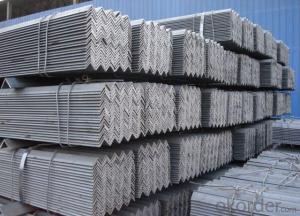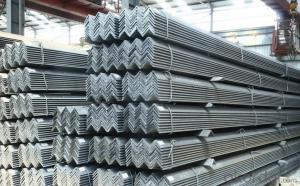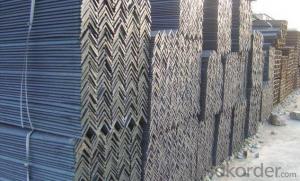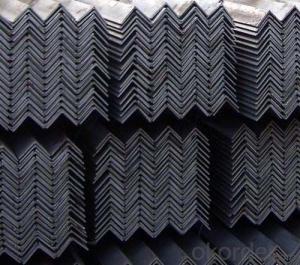Steel Equal Angle with Good Quality 125*125*8.0-14.0mm
- Loading Port:
- Tianjin
- Payment Terms:
- TT OR LC
- Min Order Qty:
- 50 m.t
- Supply Capability:
- 15000 m.t/month
OKorder Service Pledge
OKorder Financial Service
You Might Also Like
Specification
Product Description:
Specifications of Steel Equal Angle with Good Quality 125*125*8.0-14.0mm:
1. Invoicing on theoretical weight or actual weight as customer request
2. Length: 6m, 9m, 12m as following table
3. Sizes
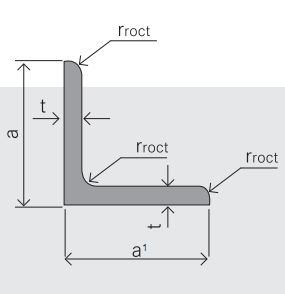
| Size(mm) | Mass(Kg/m) | Size(mm) | Mass(Kg/m) |
| 125*125*8.0 | 15.504 | 125*125*12.0 | 22.696 |
| 125*125*10.0 | 19.133 | 125*125*14.0 | 26.193 |
Payment terms:
1).100% irrevocable L/C at sight.
2).30% T/T prepaid and the balance against the copy of B/L.
3).30% T/T prepaid and the balance against L/C
Material details:
Grade | Element (%) | ||||
C | Mn | S | P | Si | |
Q235 | 0.12—0.20 | 0.3—0.7 | ≤0.045 | ≤0.045 | ≤0.3 |
Usage & Applications of Steel Equal Angle with Good Quality 125*125*8.0-14.0mm:
According to the needs of different structures, Angle can compose to different force support component, and also can be the connections between components. It is widely used in various building structures and engineering structures such as roof beams, bridges, transmission towers, hoisting machinery and transport machinery, ships, industrial furnaces, reaction tower, container frame and warehouse etc.
Packaging & Delivery of Steel Equal Angle with Good Quality 125*125*8.0-14.0mm:
1. Packing: it is nude packed in bundles by steel wire rod
2. Bundle weight: not more than 3.5MT for bulk vessel; less than 3 MT for container load
3. Marks:
Color marking: There will be color marking on both end of the bundle for the cargo delivered by bulk vessel. That makes it easily to distinguish at the destination port.
Tag mark: there will be tag mark tied up on the bundles. The information usually including supplier logo and name, product name, made in China, shipping marks and other information request by the customer.
If loading by container the marking is not needed, but we will prepare it as customer request.
Production flow of Steel Equal Angle with Good Quality 125*125*8.0-14.0mm:
Material prepare (billet) —heat up—rough rolling—precision rolling—cooling—packing—storage and transportation
FAQ:
Q1: Why buy Materials & Equipment from OKorder.com?
A1: All products offered byOKorder.com are carefully selected from China's most reliable manufacturing enterprises. Through its ISO certifications, OKorder.com adheres to the highest standards and a commitment to supply chain safety and customer satisfaction.
Q2: How do we guarantee the quality of our products?
A2: We have established an advanced quality management system which conducts strict quality tests at every step, from raw materials to the final product. At the same time, we provide extensive follow-up service assurances as required.
Q3: How soon can we receive the product after purchase?
A3: Within three days of placing an order, we will begin production. The specific shipping date is dependent upon international and government factors, but is typically 1 to 2 months.
Q4: How many tons can be loaded into one 20ft container?
A4: Around 23—25tons
Images of Steel Equal Angle with Good Quality 125*125*8.0-14.0mm:

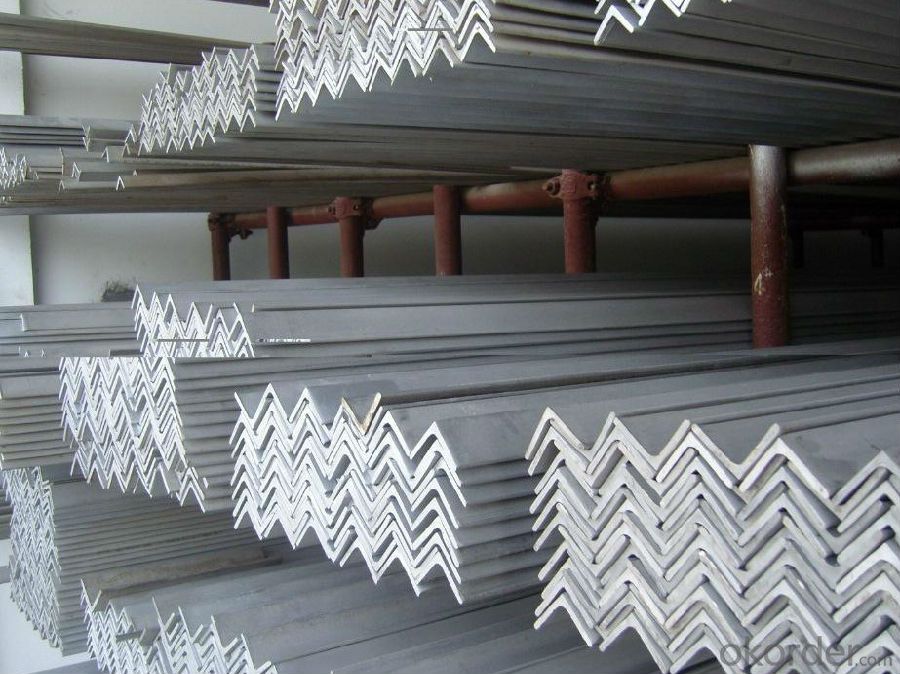
- Q: Are steel angles suitable for outdoor furniture?
- Yes, steel angles are suitable for outdoor furniture. Steel is a durable and weather-resistant material that can withstand various outdoor conditions, making it an excellent choice for outdoor furniture. Additionally, steel angles provide stability and structural support, ensuring the longevity and functionality of outdoor furniture pieces.
- Q: Can steel angles be used for framing in modular construction?
- Yes, steel angles can be used for framing in modular construction. Steel angles are commonly used for their structural strength and versatility, making them suitable for various framing applications in modular construction projects.
- Q: Can steel angles be used for modular construction?
- Yes, steel angles can be used for modular construction. Steel angles are commonly used in construction for their strength, versatility, and cost-effectiveness. In modular construction, steel angles can be used to create frames, support structures, and connections between modules. They provide stability and structural integrity to the modular units, ensuring durability and safety. Additionally, steel angles can be easily fabricated and customized to suit the specific design requirements of modular construction projects. Overall, steel angles are a viable and commonly used material in modular construction due to their numerous benefits and suitability for the construction process.
- Q: How do you protect steel angles from chemical exposure?
- To protect steel angles from chemical exposure, there are several measures that can be taken: 1. Coatings: Applying protective coatings such as epoxy, polyurethane, or powder coatings can create a barrier between the steel surface and the chemicals. These coatings are specifically designed to resist chemical attacks and provide long-term protection. 2. Galvanization: Galvanizing steel angles involves applying a layer of zinc to the surface, forming a protective barrier. This process not only protects against chemical exposure but also provides excellent corrosion resistance. 3. Chemical-resistant paint: Using chemical-resistant paint, specifically formulated to withstand exposure to certain chemicals, can provide an added layer of protection. These paints are designed to resist the corrosive effects of various chemicals and prevent damage to the steel angles. 4. Plastic or rubber linings: In some cases, steel angles can be lined with plastic or rubber materials to protect them from chemical exposure. These linings act as a barrier, preventing direct contact between the steel and chemicals. 5. Proper ventilation: Ensuring proper ventilation in the area where steel angles are exposed to chemicals is crucial. Adequate ventilation helps to disperse and dilute the chemicals, reducing the overall exposure and minimizing the corrosive effects on the steel angles. 6. Regular inspection and maintenance: Regularly inspecting the steel angles for any signs of corrosion or damage caused by chemical exposure is vital. If any damage is detected, it should be repaired promptly to prevent further deterioration. It is important to note that the choice of protection method may vary depending on the type of chemicals involved, their concentration, and the specific environment in which the steel angles are exposed. Consulting with a professional or a corrosion specialist is recommended to determine the most suitable protection strategy for a particular application.
- Q: Can steel angles be used in transportation or infrastructure projects?
- Indeed, transportation or infrastructure projects can incorporate steel angles. Owing to their robustness and endurance, steel angles are frequently employed in construction. They are commonly utilized to furnish structural reinforcement and steadiness in a myriad of scenarios, including bridges, buildings, highways, and railways. In the realm of transportation projects, steel angles can be employed to fabricate vehicle ramps, guardrails, and frameworks for overhead signs. In infrastructure projects, they can be leveraged to erect retaining walls, foundations, and frameworks for utility installations. The adaptability and dependability of steel angles render them a favored option in these particular project types.
- Q: Can steel angles be used in high-rise or multi-story buildings?
- Certainly, high-rise or multi-story buildings can incorporate steel angles into their structures. Construction often relies on steel angles because of their exceptional strength, versatility, and cost-effectiveness. When it comes to high-rise buildings, steel angles find extensive use in various structural components like beams, columns, and bracing systems. These angles effectively facilitate load and force transfer within the building, significantly enhancing overall stability and structural integrity. Furthermore, the fabrication and installation of steel angles are convenient, enabling efficient construction processes for large-scale projects. Consequently, steel angles enjoy broad acceptance and application in the construction of high-rise or multi-story buildings.
- Q: Can steel angles be used in modular construction or prefabricated structures?
- Indeed, modular construction or prefabricated structures can indeed utilize steel angles. These versatile and frequently employed structural components possess the ability to furnish modular and prefabricated buildings with both strength and stability. They are capable of constructing the skeletal framework, supporting walls, floors, and roofs, while also reinforcing connections and corners within these edifices. The preference for steel angles arises from their exceptional strength-to-weight ratio, durability, and simplicity in fabrication, rendering them a highly appropriate selection for modular and prefabricated construction endeavors.
- Q: What are the different grades of steel angles?
- The different grades of steel angles include A36, A572-50, and A588.
- Q: How do steel angles resist corrosion?
- Steel angles resist corrosion through a process called passivation. Passivation is the formation of a protective layer on the surface of the steel that acts as a barrier against corrosive elements such as moisture, oxygen, and chemicals. Steel angles are typically made from stainless steel, which contains a minimum of 10.5% chromium. Chromium is a key element that enables the formation of a thin, invisible layer of chromium oxide on the surface of the steel. This oxide layer is highly stable and prevents further corrosion from occurring. The chromium oxide layer acts as a physical barrier, protecting the underlying steel from the corrosive effects of the environment. It is also self-healing, meaning that if the oxide layer is damaged or scratched, it will naturally reform and restore its protective properties. Additionally, stainless steel angles may contain other alloying elements such as nickel and molybdenum, which further enhance their corrosion resistance. These elements contribute to the formation of a more stable oxide layer and provide additional protection against localized corrosion, such as pitting and crevice corrosion. Furthermore, steel angles can be treated with various surface finishes or coatings to enhance their resistance to corrosion. These treatments can include processes like hot-dip galvanizing, electroplating, or applying organic coatings. These additional layers act as an extra barrier, preventing corrosive substances from reaching the steel surface. Overall, steel angles resist corrosion by forming a protective layer of chromium oxide on their surface, which acts as a barrier against corrosive elements. The inclusion of other alloying elements and the application of surface treatments further enhance their ability to withstand corrosion in various environments.
- Q: How do steel angles perform under high temperatures?
- Due to their high melting point and exceptional heat resistance, steel angles exhibit excellent performance in high-temperature conditions. Steel, a widely utilized material in construction and engineering, is renowned for its robustness and durability. Steel angles, when subjected to elevated temperatures, maintain their structural integrity and do not easily deform or weaken. This is primarily due to steel's elevated melting point, typically ranging from 1370 to 1530 degrees Celsius (2500 to 2800 degrees Fahrenheit), enabling it to endure extreme heat without significant harm. Moreover, steel possesses outstanding heat resistance, enabling efficient heat dissipation and maintaining stability when confronted with high thermal loads. Consequently, steel angles are suitable for applications involving elevated temperatures, such as industrial furnaces, power plants, or high-temperature environments. However, it is crucial to acknowledge that the specific performance of steel angles under high temperatures can vary depending on the steel's grade and composition, as well as the intensity and duration of heat exposure.
Send your message to us
Steel Equal Angle with Good Quality 125*125*8.0-14.0mm
- Loading Port:
- Tianjin
- Payment Terms:
- TT OR LC
- Min Order Qty:
- 50 m.t
- Supply Capability:
- 15000 m.t/month
OKorder Service Pledge
OKorder Financial Service
Similar products
Hot products
Hot Searches
Related keywords
